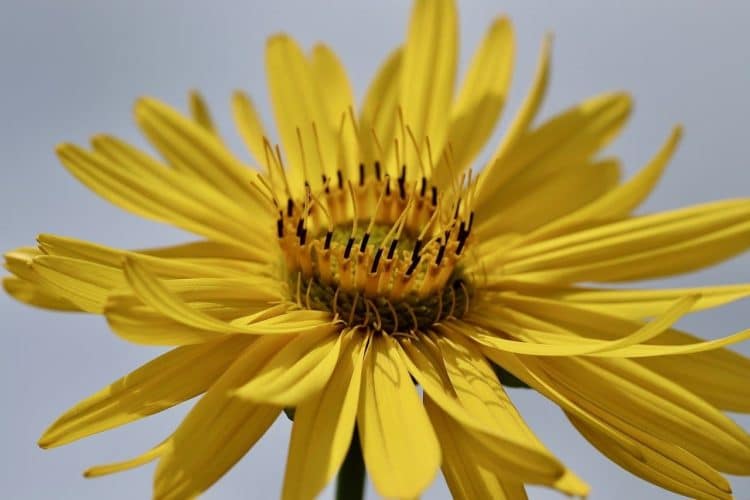Cup plant is an herb of the Silphium L., Asteraceae (daisy) family, with applications in various fields including medicine. It contains bioactive ingredients like terpenes, flavonoids, phenolic acids, and polysaccharides.
Polysaccharides have risen in popularity because of “multiple pharmacological activities such as anti-hyperglycemic, antioxidant, antitumor, immunomodulatory, [etc.],” as a group of scientists recently noted. [1] In their study, they conduct a comparison of extraction methods to amplify pharmacological activities.
The extraction strategies in question are: hot-water extraction method (HEM), ultrasonic-assisted extraction method (UEM), enzyme-assisted extraction method (EEM), and ultrasonic-enzyme-assisted extraction method (UEEM).
For HEM, water was heated to 97° C for approximately 1 hour at a flow rate of 1:15 g/mL raw material to water. The UEM used distilled water as the solvent at 55° C and 100 W, also for approximately 1 hour. The enzyme process also used water at 55° C but added a complex of enzymes with cellulase, pectinase, and papain. UEEM combined the last two methods by interrupting the ultrasound extraction 30 minutes in and adding the enzyme complex.
The comparison revealed “notable effects of extraction methods on the yields of extraction, molecular weights, uronic acid contents, monosaccharide proportions, and antioxidant activities of CPPs [cup plant polysaccharides].”
Yield
Hot water may not possess the necessary dissolving power, as HEM had the lowest yield of cup plant polysaccharides, at 6.4 ± 0.2%. EEM achieved the highest at 9.87 ± 0.20%, followed by UEEM (9.3 ± 0.1%) and UEM (8.5 ± 0.3%).
“Generally, the cell wall of [the] plant is complex and rigid; hot water treatment of HEM may not destroy the cell wall of cup plant effectively and dissolve CPPs sufficiently.”
Chemical Composition
The various extraction methods did not produce significant differences between the summed content of the four groups of polysaccharides (HEM-CPPs, UEM-CPPs, EEM-CPPs, UEEM-CPPs). Same goes for the moisture content. However, uronic acid content varied pronouncedly between different extraction methods.
HEM-CPPS had the lowest score on that front, too (2.43 +/- 0.08%), with EEM CPPs scoring the highest (4.2% +/- 0.3%). The other two methods also produced higher uronic acid levels than HEM.
“It might be that enzymolysis [and/or] cavitation during the extraction processes of EEM, UEM, and UEEM could promote the release of uronic acid from the plant cells to the extraction solvent.”
The variations in uronic acid content are in line with the findings of another study the scientists reference [2], which explored EEM, UEM, and HEM on bamboo shoot polysaccharides.
Molecular Weight
“In general, the biological activity of polysaccharides is closely related to their molecular weights.”
All four extraction methods exhibited two elution peaks with peak one having the higher molecular weight, as measured by gel filtration chromatography. EEM produced the lowest molecular weights, and hot water produced the highest.
“These results suggested the exposure to a long time of ultrasonic treatment and enzymatic hydrolysis could affect the polysaccharide molecular chain and decompose the CPPs to form the smaller ones.”
Radical Scavenging Ability (Antioxidant Activity)
EEM-CPPs displayed the highest scavenging activity on DPPH (1,1-diphenyl-2-picrylhydrazyl) and ABTS (2,2-azino-bis-(3-ethyl-benzothiazoline-6-sulfonic acid) radicals. “When the determination concentrations were greater than or equal to 0.1 mg/mL, the scavenging activity of EEM-CPPs was larger than that of ascorbic acid” on DPPH. EEM-CPPs concentrations of 0.05 to 0.5 mg/mL provided the highest antioxidant activity against ABTS, however, the authors also note that above 0.75 mg/mL, all four CPPs had equal power against ABTS radicals.
Conclusions
After performing a correlation analysis across the different parameters, the scientists attributed EEM-CPPs’ highest score in antioxidant activity to their low molecular weights and high uronic acid.
“These results indicated that EEM could [serve] as a promising technology for extracting CPP.” [1]
References:
- Wu H, et al. Comparison of different extraction methods of polysaccharides from cup plant. Process Biochemistry. 2020;90:241-248. [Impact Factor = 2.952; Times Cited = 7 (Semantic Scholar)]
- Chen GJ, et al. New insight into bamboo shoot (Chimonobambusa quadrangularis) polysaccharides: Impact of extraction processes on its prebiotic activity. Food Hydrocolloid. 2019;95:367–377. [Impact Factor: 7.053; Times Cited: 13 (Semantic Scholar)]
Image Credit: Nennieinszweidrei / Pixabay











